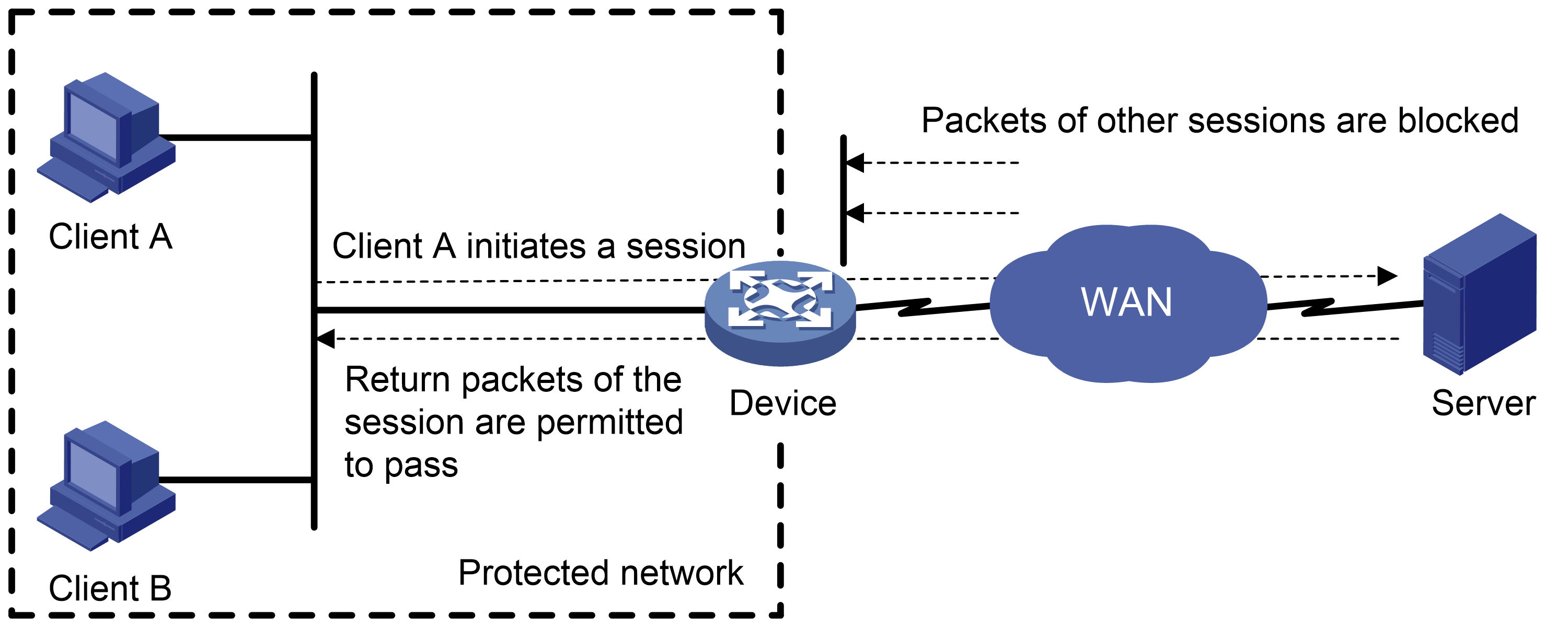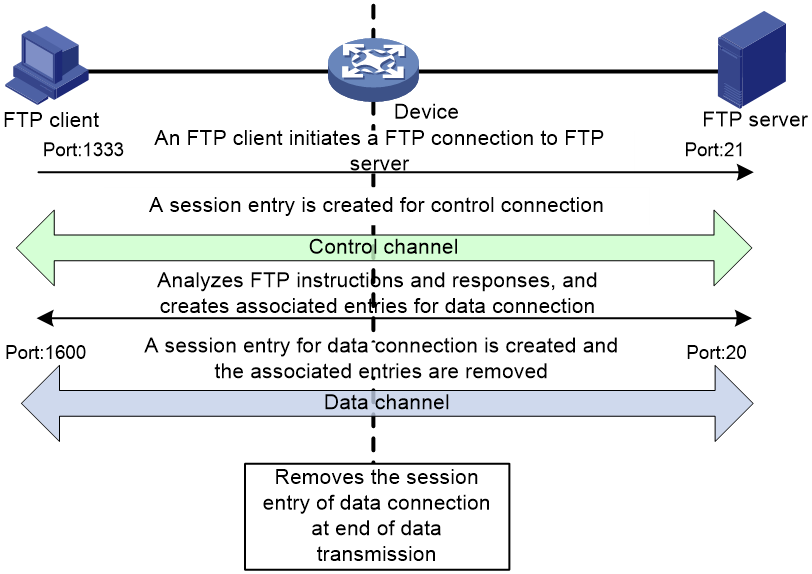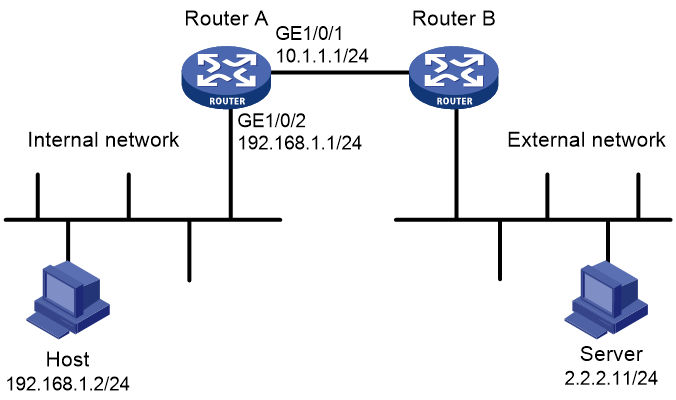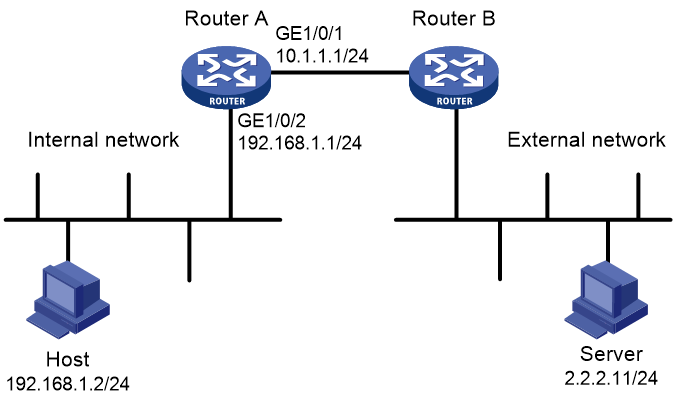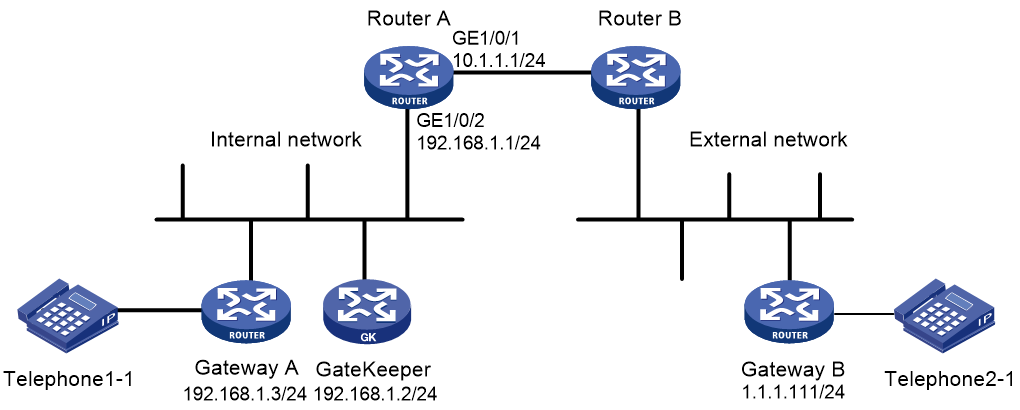- Table of Contents
-
- 12-Security Configuration Guide
- 00-Preface
- 01-Security zone configuration
- 02-AAA configuration
- 03-802.1X configuration
- 04-MAC authentication configuration
- 05-Portal configuration
- 06-Port security configuration
- 07-User profile configuration
- 08-Password control configuration
- 09-Keychain configuration
- 10-Public key management
- 11-PKI configuration
- 12-IPsec configuration
- 13-Group domain VPN configuration
- 14-SSH configuration
- 15-SSL configuration
- 16-SSL VPN configuration
- 17-ASPF configuration
- 18-APR configuration
- 19-mGRE configuration
- 20-Session management
- 21-Connection limit configuration
- 22-Object group configuration
- 23-Object policy configuration
- 24-Security policy configuration
- 25-Attack detection and prevention configuration
- 26-IP source guard configuration
- 27-ARP attack protection configuration
- 28-ND attack defense configuration
- 29-uRPF configuration
- 30-Crypto engine configuration
- 31-FIPS configuration
- 32-Application account auditing configuration
- Related Documents
-
| Title | Size | Download |
|---|---|---|
| 17-ASPF configuration | 186.72 KB |
Restrictions and guidelines: ASPF configuration
Applying an ASPF policy to an interface
Applying an ASPF policy to a zone pair
Sending ICMP error message upon packet dropping by interzone policies applied to zone pairs
Enabling real-time log sending mode
Display and maintenance commands for ASPF
Example: Configuring ASPF FTP application inspection
Example: Configuring ASPF TCP application inspection
Example: Configuring ASPF H.323 application inspection
Example: Configuring ASPF for a zone pair
Configuring ASPF
About ASPF
Advanced Stateful Packet Filter (ASPF) is proposed to address the issues that a packet-filter firewall cannot solve.
Main functions
An ASPF provides the following main functions:
· Application layer protocol inspection—ASPF checks the application layer information of packets, such as the protocol type and port number, and inspects the application layer protocol status for each connection. ASPF maintains the status information of each connection, and based on the status information, determines whether to permit a packet to pass through the firewall into the internal network. In this way, ASPF defends the internal network against attacks.
· Transport layer protocol inspection—ASPF checks the transportation layer information of packets. Transportation layer protocol includes TCP, UDP, UDP-Lite, SCTP, Raw IP, ICMP, ICMPv6, and DCCP. For example, ASPF checks a TCP/UDP packet's source and destination addresses and port numbers to determine whether to permit the packet to pass through the firewall into the internal network.
· ICMP error message dropping—ASPF inspects the connection information carried in an ICMP error message. If the information does not match the connection, ASPF drops the packet.
· TCP SYN check—ASPF checks the first packet of a TCP connection to determine if it is a SYN packet. If it is not a SYN packet, ASPF drops the packet. When a router attached to the network starts up, it can receive a non-SYN packet of an existing TCP connection for the first time. If you do not want to interrupt the existing TCP connection, you can disable the TCP SYN check. The router allows the first non-SYN packet that is used to establish a TCP connection to pass. After the network topology becomes steady, you can enable TCP SYN check again.
ASPF application
At the border of a network, ASPF can work with a packet-filter firewall to provide the network with a more comprehensive security policy that better meets the actual needs. The packet-filter firewall permits or denies packets according to ACL rules. The ASPF records information about the permitted packets to ensure that their return packets can pass through the packet-filter firewall.
Basic ASPF concepts
Single-channel protocol and multichannel protocol
· Single-channel protocol—A single-channel protocol establishes only one connection to exchange both control messages and data for a user. SMTP and HTTP are examples of single-channel protocols.
· Multichannel protocol—A multichannel protocol establishes more than one connection for a user and transfers control messages and user data through different connections. FTP is one example of multichannel protocols.
Internal interface and external interface
On an edge device configured with ASPF to protect hosts and servers on the internal network, the interfaces on the device are divided into internal interfaces and external interface:
· Internal interfaces—Interfaces connected to the internal network.
· External interfaces—Interfaces connected to the external network.
To protect the internal network, you can apply an ASPF in the outbound direction of the external interfaces or in the inbound direction of the internal interfaces of the device.
Zone pair
A zone pair specifies the source zone and destination zone of a traffic flow to be inspected:
· Source zone—A security zone from which the first packet of a traffic flow originates.
· Destination zone—A security zone for which the first packet of a traffic flow is destined.
For information about security zones, see "Configuring security zones."
ASPF inspection principles
This section introduces the basic idea of ASPF inspection on application layer and transport layer protocols.
Application layer protocol inspection
As shown in Figure 1, ACLs on the edge device deny incoming packets to the internal network. The ASPF application layer protocol inspection allows return packets from the external network to the internal network.
Figure 1 Application layer protocol inspection
ASPF inspects all application layer sessions as follows:
· For a single-channel protocol, such as HTTP, the inspection process is simple.
ASPF creates a session entry immediately after it detects the session's first packet sent to the external network, and ASPF removes the entry when the connection is terminated.
The session entry helps record outgoing packets and their return packets. It can maintain the session status and determine whether state transitions of the session are correct. All packets that match a session entry can pass through the packet-filter firewall.
· For a multichannel protocol, ASPF creates session entries, and one or more associated entries to associate the sessions initiated by the same application layer protocol. Associated entries are created during the protocol negotiation and are removed after the negotiation. ASPF uses the associated entries to match the first packets of the sessions. All packets of the sessions matching the associated entries can pass through the packet-filter firewall.
The following uses FTP to explain the process of multichannel application layer protocol inspection.
Figure 2 FTP inspection
As shown in Figure 2, FTP connections are established and removed as follows:
1. The FTP client initiates an FTP control connection from port 1333 to port 21 of the FTP server.
2. As a result of negotiation, the server initiates a data connection from port 20 to port 1600 of the client.
3. When data transmission times out or ends, the data connection is removed.
ASPF implements FTP inspection during the FTP connection lifetime as follows:
1. ASPF checks the IP packets the FTP client sends to the FTP server to identify TCP-based FTP packets. Based on the port number, ASPF identifies the control connection between the FTP client and server and creates a control connection session entry.
2. ASPF checks each FTP control connection packet, and examines their TCP status based on the control connection session entry. ASPF analyzes the FTP instructions in the control connection packet. If the packet contains a data channel setup instruction, ASPF creates an associated entry for the data connection.
3. For return FTP control connection packets, ASPF examines their TCP status based on the control connection session entry to make packet forwarding decisions.
4. When the FTP data passes through the device, ASPF is triggered to create a session entry for the data connection and remove the associated entry.
5. For returned FTP data packets, ASPF examines their TCP status based on the data connection session entry to make packet forwarding decisions.
6. When the data transmission ends, ASPF removes the data connection session entry. When the FTP connection is removed, ASPF removes the control connection session entry.
Transport layer protocol inspection
The transport layer protocol inspection requires that return packets must match the corresponding packets that are previously sent out of the external interface. The return packets must have the same source/destination addresses and source/destination port numbers as the outgoing packets (but reversed). Otherwise, the return packets are blocked. For multichannel application layer protocols like FTP, the deployment of TCP inspection without application layer inspection leads to failure of establishing a data connection.
Restrictions and guidelines: ASPF configuration
ASPF inspection is required to ensure successful data connections for multichannel protocols when either of the following conditions exists:
· The ALG feature is disabled in other service modules (such as NAT).
· Other service modules with the ALG feature (such as DPI) are not configured.
ASPF inspection is optional for multichannel protocols if ALG is enabled in other service modules or if other service modules with the ALG feature are configured.
Application protocols supported by the detect command (except HTTP, SMTP, and TFTP) are multichannel protocols.
ASPF inspection for transport layer protocols is always enabled and is not configurable.
ASPF also supports protocol status validity check for application layer protocols of DNS, FTP, H323, HTTP, SCCP, SIP, and SMTP. ASPF deals with packets with invalid protocol status, depending on the actions you have specified. For other application layer protocols, ASPF does not perform the protocol status validity check, and it only maintains connection status information.
ASPF tasks at a glance)
To configure ASPF, perform the following tasks:
2. Applying an ASPF policy
Choose one of the following tasks:
¡ Applying an ASPF policy to an interface
¡ Applying an ASPF policy to a zone pair
3. (Optional.) Sending ICMP error message upon packet dropping by interzone policies applied to zone pairs
4. (Optional.) Enabling real-time log sending mode
Configuring an ASPF policy
1. Enter system view.
system-view
2. Create an ASPF policy and enter its view.
aspf-policy aspf-policy-number
After an ASPF policy is created, ASPF inspection for transport layer protocols is always enabled and is not configurable.
3. (Optional.) Configure ASPF inspection for application layer protocols.
detect { dns [ action { drop | logging } * ] | { ftp | h323 | http | sccp | sip | smtp } [ action drop ] | gtp | ils | mgcp | nbt | pptp | rsh | rtsp | sqlnet | tftp | xdmcp }
By default, ASPF inspection for FTP is configured.
The action keyword enables protocol status validity check for application protocols. ASPF takes the predefined actions on packets with invalid protocol status.
4. (Optional.) Enable ICMP error message dropping.
icmp-error drop
By default, ICMP error message dropping is disabled. ASPF does not drop faked ICMP error messages.
5. (Optional.) Enable TCP SYN check.
tcp syn-check
By default, TCP SYN check is disabled. ASPF does not drop the non-SYN packet when it is the first packet to establish a TCP connection.
Applying an ASPF policy to an interface
About this task
You can apply an ASPF policy to inspect incoming or outgoing traffic on an interface. ASPF compares the packets against session entries. If a packet does not match any session entries, ASPF creates a new session entry.
You can apply both ASPF and packet filter to implement packet filtering. For example, you can apply a packet filtering policy to the inbound direction of the external interface and apply an ASPF policy to the outbound direction of the external interface. The application denies unsolicited access from the external network to the internal network and allows return packets from external to the internal network.
Restrictions and guidelines
An ASPF stores and maintains the application layer protocol status based on interfaces. Make sure a connection initiation packet and the corresponding return packet pass through the same interface.
Procedure
1. Enter system view.
system-view
2. Enter interface view.
interface interface-type interface-number
3. Apply an ASPF policy to the interface.
aspf apply policy aspf-policy-number { inbound | outbound }
By default, no ASPF policy is applied to the interface.
Applying an ASPF policy to a zone pair
About this task
You can apply an ASPF policy to a zone pair to inspect traffic from the source zone to the destination zone. ASPF compares all packets with session entries. If a packet that is permitted by packet filtering does not match any existing session entries, ASPF creates a new session entry.
ASPF for a zone pair takes effect only when it functions with a packet filter:
· The packet filter allows only solicited access from the source zone to the network that the destination zone connects.
· The ASPF policy compares the packets against session entries and allows matching packets from the source zone to the destination zone. The policy also allows return packets from the destination zone to the source zone.
Procedure
1. Enter system view.
system-view
2. Enter zone pair view.
zone-pair security source source-zone-name destination destination-zone-name
For information about configuring a zone pair, see "Configuring security zones."
3. Apply an ASPF policy to the zone pair.
aspf apply policy aspf-policy-number
By default, the predefined ASPF policy is applied to the zone pair.
With the predefined policy, ASPF inspects FTP packets and packets of all transport layer protocols, but it does not perform ICMP error message check or TCP SYN packet check.
Sending ICMP error message upon packet dropping by interzone policies applied to zone pairs
About this task
By default, the device drops packets that do not match interzone policies applied to zone pairs, and it does not send ICMP error messages for the dropping events. This mechanism reduces useless packets transmitted over the network and saves bandwidth.
Enable this feature when you use traceroute because ICMP error messages in this situation are required.
Procedure
1. Enter system view.
system-view
2. Enable the device to send ICMP error messages upon packet dropping by interzone policies applied to zone pairs.
aspf icmp-error reply
By default, the device does not send ICMP error messages when the device drops packets that do not match interzone policies applied to zone pairs.
Enabling real-time log sending mode
About this task
Real-time log sending mode takes effect only on logs sent by the object policy and packet filtering features.
The device supports the following log sending modes:
· Cache log sending mode—When the first packet of a flow matches a policy, the device generates a log and caches it and starts a five-minute timer at the same time. If the log matches traffic within five minutes, the device sends the log when the timer expires. If the log does not match any traffic within five minutes, the device deletes the log. The device stops generating logs if the number of cached logs reaches the upper limit.
· Real-time log sending mode—When the first packet of a flow matches a policy, the device sends a log immediately. For a policy that permits specific packets, the device sends only one log for a flow that matches the policy. For a policy that denies specific packets, the device sends a log for each packet of a flow that matches the policy. The number of logs is not limited.
For more information about logging configuration of the object policy and packet filtering features, see "Configuring object policies" and ACL and QoS Configuration Guide.
Procedure
1. Enter system view.
system-view
2. Enable real-time log sending mode.
aspf log sending-realtime enable
By default, real-time log sending mode is disabled. Logs are cached before they are sent.
Display and maintenance commands for ASPF
Execute display commands in any view and reset commands in user view.
|
Task |
Command |
|
Display the configuration of all ASPF policies and their applications to interfaces. |
display aspf all |
|
Display ASPF policy applications to interfaces. |
display aspf interface |
|
Display the configuration of an ASPF policy. |
display aspf policy { aspf-policy-number | default } |
|
Display ASPF sessions. |
In standalone mode: display aspf session [ ipv4 | ipv6 ] [ verbose ] In IRF mode: display aspf session [ ipv4 | ipv6 ] [ slot slot-number ] [ verbose ] |
|
Clear ASPF session statistics. |
In standalone mode: reset aspf session [ ipv4 | ipv6 ] In IRF mode: reset aspf session [ ipv4 | ipv6 ] [ slot slot-number ] |
ASPF configuration examples
Example: Configuring ASPF FTP application inspection
Network configuration
Configure an ASPF policy on Router A to inspect the FTP traffic flows passing through Router A. Only return packets for FTP connections initiated by users on the internal network are permitted to pass through Router A and get into the internal network. All other types of packets from the external network to the internal network are blocked.
Procedure
# Configure ACL 3111 to deny all IP packets.
<RouterA> system-view
[RouterA] acl advanced 3111
[RouterA-acl-ipv4-adv-3111] rule deny ip
[RouterA-acl-ipv4-adv-3111] quit
# Create ASPF policy 1 for FTP inspection.
[RouterA] aspf-policy 1
[RouterA-aspf-policy-1] detect ftp
[RouterA-aspf-policy-1] quit
# Apply ACL 3111 to deny all incoming IP packets on GigabitEthernet 1/0/1.
[RouterA] interface gigabitethernet 1/0/1
[RouterA-GigabitEthernet1/0/1] packet-filter 3111 inbound
# Apply ASPF policy 1 to the outgoing traffic on GigabitEthernet 1/0/1.
[RouterA-GigabitEthernet1/0/1] aspf apply policy 1 outbound
[RouterA-GigabitEthernet1/0/1] quit
Verifying the configuration
# Verify that an ASPF session has been established for the FTP connection between the host and the FTP server.
[RouterA] display aspf session ipv4
Slot 0:
Initiator:
Source IP/port: 192.168.1.2/1877
Destination IP/port: 2.2.2.11/21
VPN instance/VLAN ID/Inline ID: -/-/-
Protocol: TCP(6)
Inbound interface: GigabitEthernet1/0/1
Total sessions found: 1
# Verify that only the return packets of FTP connections can enter the internal network. (Details not shown.)
Example: Configuring ASPF TCP application inspection
Network configuration
Local users on the internal network need to access the external network. To protect the internal network against ICMP and SYN packet attacks from the external network, configure an ASPF policy on Router A. Router A can then drop faked ICMP error messages and non-SYN packets that are the first packets over TCP connections.
Procedure
# Configure ACL 3111 to deny all IP packets.
<RouterA> system-view
[RouterA] acl advanced 3111
[RouterA-acl-ipv4-adv-3111] rule deny ip
[RouterA-acl-ipv4-adv-3111] quit
# Create ASPF policy 1.
[RouterA] aspf-policy 1
# Enable ICMP error message dropping.
[RouterA-aspf-policy-1] icmp-error drop
# Enable TCP SYN check.
[RouterA-aspf-policy-1] tcp syn-check
[RouterA-aspf-policy-1] quit
# Enable ASPF policy 1 to inspect FTP packets.
[RouterA-aspf-policy-1] detect ftp
# Apply ACL 3111 to deny all incoming IP packets on GigabitEthernet 1/0/1.
[RouterA] interface gigabitethernet 1/0/1
[RouterA-GigabitEthernet1/0/1] packet-filter 3111 inbound
# Apply ASPF policy 1 to outgoing traffic on GigabitEthernet 1/0/1.
[RouterA-GigabitEthernet1/0/1] aspf apply policy 1 outbound
[RouterA-GigabitEthernet1/0/1] quit
Verifying the configuration
# Display the configuration of ASPF policy 1.
[RouterA] display aspf policy 1
ASPF policy configuration:
Policy number: 1
ICMP error message check: Enabled
TCP SYN packet check: Enabled
Inspected protocol Action
FTP None
Router A can recognize faked ICMP error messages from external networks, and drop the non-SYN packets that are the first packets to establish TCP connections.
Example: Configuring ASPF H.323 application inspection
Network configuration
Figure 5 displays a typical H.323 application network. Gateway B on the external network needs to access the H.323 Gatekeeper, and with the assistance of Gatekeeper, to establish a connection with the H.323 Gateway A. Other protocol packets from the external network are dropped.
Configure a packet filter on Router A to permit only packets destined to the Gatekeeper. Configure an ASPF policy on Router A to detect H.323 protocol packets so that return packets to the external network can be passed through GigabitEthernet 1/0/1.
Procedure
# Create ACL 3200 and configure two rules in the ACL: one to permit packets destined to Gatekeeper to pass, and one to deny all IP packets.
<RouterA> system-view
[RouterA] acl advanced 3200
[RouterA-acl-ipv4-adv-3200] rule 0 permit ip destination 192.168.1.2 0
[RouterA-acl-ipv4-adv-3200] rule 5 deny ip
[RouterA-acl-ipv4-adv-3200] quit
# Create ASPF policy 1 for H.323 inspection.
[RouterA] aspf policy 1
[RouterA-aspf-policy-1] detect h323
[RouterA-aspf-policy-1] quit
# Apply ACL 3200 to filter incoming packets on GigabitEthernet 1/0/1.
[RouterA] interface gigabitethernet 1/0/1
[RouterA-GigabitEthernet1/0/1] packet-filter 3200 inbound
# Apply ASPF policy 1 to incoming traffic on GigabitEthernet 1/0/1.
[RouterA-GigabitEthernet1/0/1] aspf apply policy 1 inbound
[RouterA-GigabitEthernet1/0/1] quit
Verifying the configuration
# Verify that ASPF sessions have been created between Gateway B and Gatekeeper/Gateway A.
[RouterA] display aspf session ipv4
Slot 0:
Initiator:
Source IP/port: 1.1.1.111/33184
Destination IP/port: 192.168.1.3/32828
VPN instance/VLAN ID/Inline ID: -/-/-
Protocol: UDP(17)
Inbound interface: GigabitEthernet1/0/1
Initiator:
Source IP/port: 1.1.1.111/1719
Destination IP/port: 192.168.1.2/1719
VPN instance/VLAN ID/Inline ID: -/-/-
Protocol: UDP(17)
Inbound interface: GigabitEthernet1/0/1
Initiator:
Source IP/port: 1.1.1.111/3521
Destination IP/port: 192.168.1.2/20155
VPN instance/VLAN ID/Inline ID: -/-/-
Protocol: TCP(6)
Inbound interface: GigabitEthernet1/0/1
Initiator:
Source IP/port: 1.1.1.111/33185
Destination IP/port: 192.168.1.3/32829
VPN instance/VLAN ID/Inline ID: -/-/-
Protocol: UDP(17)
Inbound interface: GigabitEthernet1/0/1
Initiator:
Source IP/port: 1.1.1.111/3688
Destination IP/port: 192.168.1.2/1720
VPN instance/VLAN ID/Inline ID: -/-/-
Protocol: TCP(6)
Inbound interface: GigabitEthernet1/0/1
Total sessions found: 5
# Verify that only return packets that match the entries can pass through GigabitEthernet 1/0/1. (Details not shown.)
Example: Configuring ASPF for a zone pair
Network configuration
Configure an ASPF policy on the router to inspect FTP traffic that passes through the router to implement the following filtering:
· Permits only return packets for the FTP connections initiated by users on the internal network to pass through the router .
· Blocks all other types of packets from the external network to the internal network.
Figure 6 Network diagram
Procedure
# Configure ACL 3500 to permit IP packets.
<Router> system-view
[Router] acl advanced 3500
[Router-acl-ipv4-adv-3500] rule permit ip
[Router-acl-ipv4-adv-3500] quit
# Add GigabitEthernet 1/0/2 to security zone Trust.
[Router] security-zone name trust
[Router-security-zone-Trust] import interface gigabitethernet 1/0/2
[Router-security-zone-Trust] quit
# Add GigabitEthernet 1/0/1 to security zone Untrust.
[Router] security-zone name untrust
[Router-security-zone-Untrust] import interface gigabitethernet 1/0/1
[Router-security-zone-Untrust] quit
# Create ASPF policy 1 for FTP inspection.
[Router] aspf policy 1
[Router-aspf-policy-1] detect ftp
[Router-aspf-policy-1] quit
# Create a zone pair and enter its view.
[Router] zone-pair security source trust destination untrust
# Apply the ACL to filter to permit outgoing packets in the zone pair.
[Router-zone-pair-security-Trust-Untrust] packet-filter 3500
# Apply the ASPF policy to the zone pair.
[Router-zone-pair-security-Trust-Untrust] aspf apply policy 1
[Router-zone-pair-security-Trust-Untrust] quit
Verifying the configuration
# Verify that an ASPF session has been established for the FTP connection between the host and the server.
[Router] display aspf session ipv4
Slot 0:
Initiator:
Source IP/port: 192.168.1.2/1877
Destination IP/port: 2.2.2.11/21
VPN instance/VLAN ID/Inline ID: -/-/-
Protocol: TCP(6)
Inbound interface: GigabitEthernet1/0/2
Source security zone: Trust
Total sessions found: 1
# Verify that only return packets that match the entries can enter the internal network. (Details not shown.)

